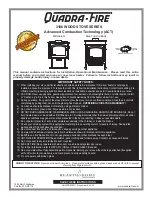
5
to setting 1 and the burner should then settle down into blue
flame combustion.
9b. If it dies down into the bottom of the pot and goes yellow
this is a sign that there is insufficient oil coming into the pot.
Note there may be the occasional growl or audible vibration
whilst the burner settles down into blue flame combustion.
Do not turn the oil control knob up by any more than one
increment.
Allow 2 minutes for the burner to stabilize at each adjustment.
Make sure that you keep your eye on the stove for the first
half hour after it has first been ignited.
5-3 STOVES WITH BOILERS
1. Stove with hot water boilers are run in exactly the same way
as stoves without but there are extra controls detailed in the
booklet supplied with the stove.
6
6
-
-
0
0
F
F
A
A
U
U
L
L
T
T
F
F
I
I
N
N
D
D
I
I
N
N
G
G
6-1. RACING
1. Audible vibrations generated by the flame caused allowing
by too much oil in the pot, too quickly.
1-1. Turn off the oil flow until the burner has settled down to a
steady burn rate and then turn the fuel on again but don’t let the
flame go out otherwise the burner MUST be allowed to cool
down fully before a re-ignition is attempted.
6-2. FLUE VACUUM
1. The pot type burner is extremely sensitive to flue vacuum
variations.
2. Good combustion will not be possible unless our instructions
on chimneys and flue vacuum are followed.
3. If the burner does not burn with a blue flame, recheck the
chimney vacuum and oil flow rate.
4. If the burner does not run well check that the seals in the
stove are good and that there is no ingress of air into the
appliance flue ways.
6. Check that the correct fuel oil is being used.
7. Check the levels.
6-3. BURNER RUNS SOOTY.
Comments made on this subject assume that the appliance has
been running normally for some time.
1. If the stove soot’s up this indicates that there is not adequate
air for blue flame combustion or there is an excess of fuel.
1-1. Check that the chimney is working correctly. (This means
pulling enough air into the burner to allow correct blue flame
combustion to occur.
1-2. Check that the fuel is the correct type and quality.
1-3. Check that the flow rates are correct.
2. Where burners are incorrectly installed and are allowed to
run at high fuel flow rates on low chimney vacuums, long
unsatisfactory yellow flame combustion and bad sooting will
occur.
2-1. To rectify this problem call your service engineer.
3. Never switch from low settings straight up to high settings, a
longer burner life will be achieved if the oil flow control knob
is moved only by one number at a time leaving approx. two
minutes between each setting change.
6-4. BURNER DOES NOT LIGHT EASILY
Read the instructions in the lighting section of this publication.
6-5. OIL WILL NOT ENTER THE POT
All stoves
1. Is there oil in the fuel tank?
2. Has the fire valve or valves tripped.
3. Has the isolation valve been accidentally turned off?
4. Is the oil turned on at the oil flow control knob on the valve?
6. Is the oil feed pipe from the valve to the pot blocked.
(Unlikely)
(STOVES WITH BOILERS)
7. Has the oil trip lever tripped off?
8. Has the boiler stat tripped off?
6-7. OPERATING OIL FLOW RATES
OIL Flow rates in cc per minute.
min
max
3cc
9cc
Oil Flow Rates In litres Per hour.
.18 litres
.54 litres
Oil Flow Rates In litres Per 24 hours.
4.32 litres
12.96 litre
Oil Flow Rates In litres Per 7 x 24 hours.
30.24 litres
90.72 litres
To achieve optimum burner performance at these flow rates you
will need to have matching flue vacuums as stated in section 2.
6-8. OIL SMELLS
Visual check on all joints for obvious leaks.
Oil smells can be traced better when the stove is out.
The main cause of oil smell is lack of adjustment and service to
the descaling device.
Check that the descaling lever packing gland nut is adjusted.
6-9. DE-FLOODING A FLOODED POT.
If the stove is blown out by severe downdraughting, oil will run
into the pot to a depth of approx 15mm and then stop. If this has
occurred do not attempt to light the pot until it has been de
flooded.
To carry out this procedure you will need -:
a. A small leak proof plastic bag.
b. A small sponge.
c. A larger plastic bag for disposal of the residue.

























